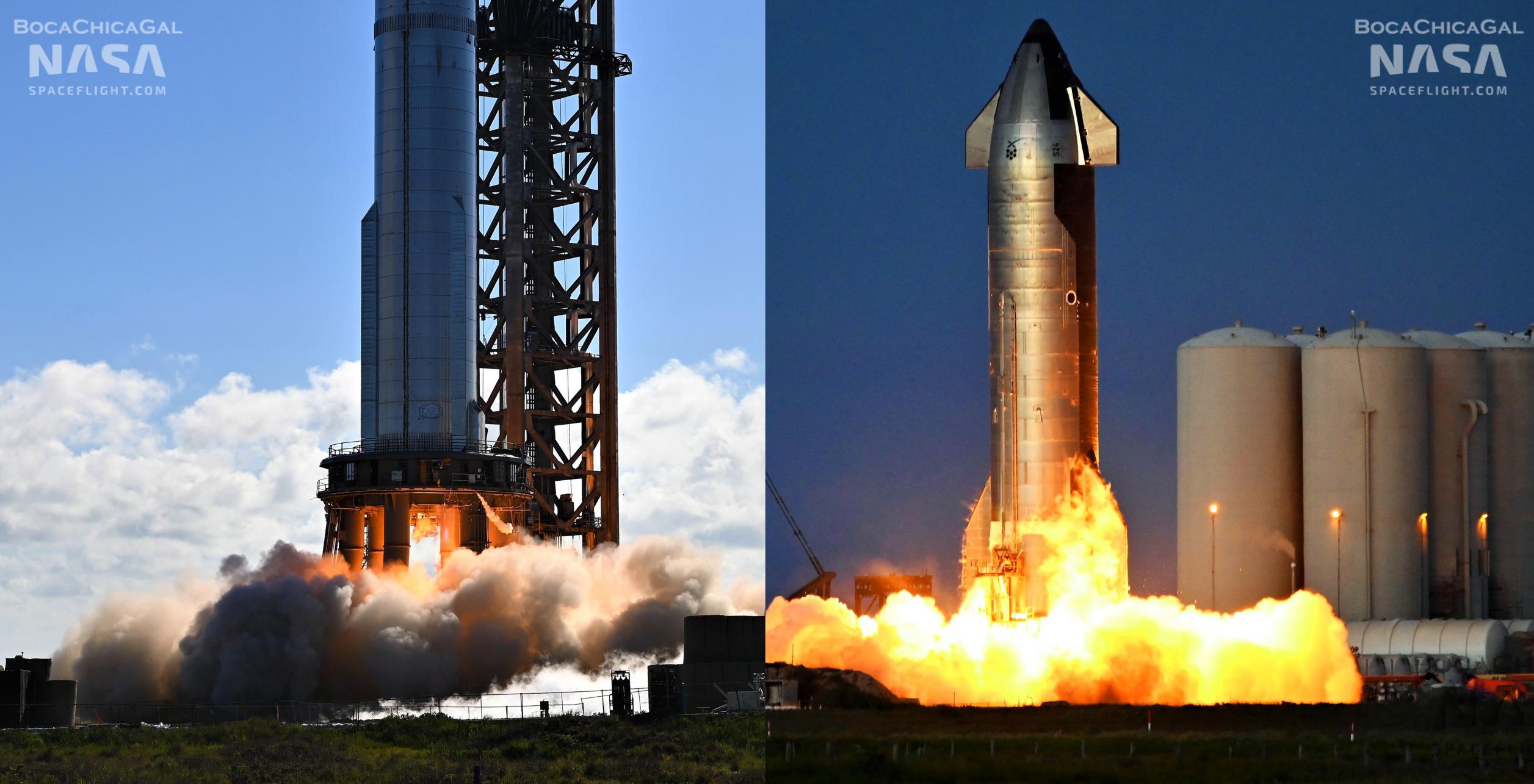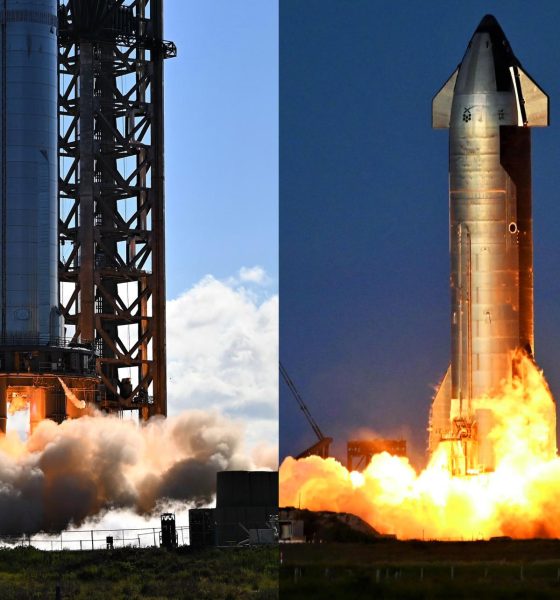

News
SpaceX fires up Starship and Super Heavy booster hours apart
SpaceX appears to have successfully fired up a Starship and Super Heavy booster hours apart, testing a total of three new Raptor 2 engines on the two rockets.
SpaceX says it completed a two-engine static fire with Starship 24 less than three hours after the company successfully ignited a Raptor 2 engine installed on a rocket prototype for the first time. That earlier test, performed by Super Heavy Booster 7, was also the first time SpaceX used its new Starbase orbital launch site to support a static fire test and the second-ever static fire of a Starship booster prototype. Had the company called it quits after Booster 7 survived its first intentional trial by fire, it would have still been an exceptionally successful day.
But SpaceX wasn’t done.
Instead, after Booster 7’s seemingly flawless single-Raptor static fire at 5:25 pm CDT, SpaceX loaded Starship 24 with a small amount of liquid oxygen and methane propellant and ignited two of the ship’s six engines around 8:18 pm. It was not initially clear how many engines were involved but a tweet from SpaceX later confirmed it was two. More likely than not, one of those engines was a sea level-optimized Raptor with a smaller bell nozzle and the other was a vacuum-optimized Raptor with a much larger nozzle.
Almost ten months ago, Starship 20 – SpaceX’s first potentially orbital-class Starship prototype – began static fire testing in a somewhat similar way. Its first day of static fires began with a single Raptor Vacuum engine and ended with a simultaneous RVac and sea-level Raptor test in October 2021. In some ways, SpaceX has been a bit less cautious with Starship 24, which is the second potentially orbital-class prototype to begin proof testing. Ship 24 already has all six Raptors installed, whereas Ship 20 only had four of six engines installed during its first static fire tests. SpaceX also took about three weeks to progress from Ship 20’s first static fire test to its first static fire of all six engines, whereas it appears that Ship 24 could potentially attempt its first six-engine test just a few days to a week later.
On the other hand, Ship 24’s path to its first static fire was substantially longer than Ship 20’s. Ship 20 completed its first static fire test(s) just 25 days after its first proof test, referring to the process of verifying that the prototype was in good working order before moving on to riskier testing with flammable propellant and intentional ignitions. Ship 20 also completed its first six-engine static fire 46 days after testing began. Ship 24, meanwhile, took 75 days to go from its first proof test to its first static fire – almost three times slower than Ship 20, a prototype that was essentially the first of its kind.
It’s possible that Ship 24’s upgraded Raptor 2 engines are partially or fully to blame. Instead of jumping straight into ‘hot’ Raptor testing like Ship 20, which began that particular campaign with a partial-ignition preburner test, SpaceX put Ship 24 through seven ‘spin-prime’ tests before its first static fire. For Raptor, spin-primes test the ignition step before preburner ignition, which is itself a step before main combustion chamber ignition (where the engine starts to produce meaningful thrust). Raptor startup procedures likely involve flowing high-pressure gaseous helium, nitrogen, or propellant (oxygen/methane) through the engine to spin up its turbopumps, ‘priming’ them for preburner and main combustion chamber ignition.
On Raptor 1, the preburners would ignite once a high enough flow rate was achieved, producing hot gas that the main combustion chamber would mix and ignite one last time to start the engine. In a recent interview with Tim Dodd (“The Everyday Astronaut”), CEO Elon Musk revealed that SpaceX was able to “remove torch igniters” from Raptor 2’s main combustion chamber (MCC). It’s unclear if that means that Raptor 2 now has zero MCC igniters, but a major change in the overall ignition process could explain why the start of Ship 24 and Booster 7 engine testing was so sluggish. So could the unintended explosion Booster 7 caused when SpaceX attempted to spin-prime all 33 of its Raptor 2 engines at once.
Regardless, SpaceX has finally crossed that particular Rubicon and, with any luck, Raptor 2 testing will begin to speed up on both Starship 24 and Super Heavy Booster 7. SpaceX has test windows scheduled on August 11th, 15th, and 16th. A warning distributed to Boca Chica, Texas residents on August 10th confirmed that the company intends to perform at least one more static fire test on the 11th.

News
Tesla FSD fleet is nearing 7 billion total miles, including 2.5 billion city miles
As can be seen on Tesla’s official FSD webpage, vehicles equipped with the system have now navigated over 6.99 billion miles.

Tesla’s Full Self-Driving (Supervised) fleet is closing in on almost 7 billion total miles driven, as per data posted by the company on its official FSD webpage.
These figures hint at the massive scale of data fueling Tesla’s rapid FSD improvements, which have been quite notable as of late.
FSD mileage milestones
As can be seen on Tesla’s official FSD webpage, vehicles equipped with the system have now navigated over 6.99 billion miles. Tesla owner and avid FSD tester Whole Mars Catalog also shared a screenshot indicating that from the nearly 7 billion miles traveled by the FSD fleet, more than 2.5 billion miles were driven inside cities.
City miles are particularly valuable for complex urban scenarios like unprotected turns, pedestrian interactions, and traffic lights. This is also the difference-maker for FSD, as only complex solutions, such as Waymo’s self-driving taxis, operate similarly on inner-city streets. And even then, incidents such as the San Francisco blackouts have proven challenging for sensor-rich vehicles like Waymos.
Tesla’s data edge
Tesla has a number of advantages in the autonomous vehicle sector, one of which is the size of its fleet and the number of vehicles training FSD on real-world roads. Tesla’s nearly 7 billion FSD miles then allow the company to roll out updates that make its vehicles behave like they are being driven by experienced drivers, even if they are operating on their own.
So notable are Tesla’s improvements to FSD that NVIDIA Director of Robotics Jim Fan, after experiencing FSD v14, noted that the system is the first AI that passes what he described as a “Physical Turing Test.”
“Despite knowing exactly how robot learning works, I still find it magical watching the steering wheel turn by itself. First it feels surreal, next it becomes routine. Then, like the smartphone, taking it away actively hurts. This is how humanity gets rewired and glued to god-like technologies,” Fan wrote in a post on X.
News
Tesla starts showing how FSD will change lives in Europe
Local officials tested the system on narrow country roads and were impressed by FSD’s smooth, human-like driving, with some calling the service a game-changer for everyday life in areas that are far from urban centers.

Tesla has launched Europe’s first public shuttle service using Full Self-Driving (Supervised) in the rural Eifelkreis Bitburg-Prüm region of Germany, demonstrating how the technology can restore independence and mobility for people who struggle with limited transport options.
Local officials tested the system on narrow country roads and were impressed by FSD’s smooth, human-like driving, with some calling the service a game-changer for everyday life in areas that are far from urban centers.
Officials see real impact on rural residents
Arzfeld Mayor Johannes Kuhl and District Administrator Andreas Kruppert personally tested the Tesla shuttle service. This allowed them to see just how well FSD navigated winding lanes and rural roads confidently. Kruppert said, “Autonomous driving sounds like science fiction to many, but we simply see here that it works totally well in rural regions too.” Kuhl, for his part, also noted that FSD “feels like a very experienced driver.”
The pilot complements the area’s “Citizen Bus” program, which provides on-demand rides for elderly residents who can no longer drive themselves. Tesla Europe shared a video of a demonstration of the service, highlighting how FSD gives people their freedom back, even in places where public transport is not as prevalent.
What the Ministry for Economic Affairs and Transport says
Rhineland-Palatinate’s Minister Daniela Schmitt supported the project, praising the collaboration that made this “first of its kind in Europe” possible. As per the ministry, the rural rollout for the service shows FSD’s potential beyond major cities, and it delivers tangible benefits like grocery runs, doctor visits, and social connections for isolated residents.
“Reliable and flexible mobility is especially vital in rural areas. With the launch of a shuttle service using self-driving vehicles (FSD supervised) by Tesla in the Eifelkreis Bitburg-Prüm, an innovative pilot project is now getting underway that complements local community bus services. It is the first project of its kind in Europe.
“The result is a real gain for rural mobility: greater accessibility, more flexibility and tangible benefits for everyday life. A strong signal for innovation, cooperation and future-oriented mobility beyond urban centers,” the ministry wrote in a LinkedIn post.
News
Tesla China quietly posts Robotaxi-related job listing
Tesla China is currently seeking a Low Voltage Electrical Engineer to work on circuit board design for the company’s autonomous vehicles.

Tesla has posted a new job listing in Shanghai explicitly tied to its Robotaxi program, fueling speculation that the company is preparing to launch its dedicated autonomous ride-hailing service in China.
As noted in the listing, Tesla China is currently seeking a Low Voltage Electrical Engineer to work on circuit board design for the company’s autonomous vehicles.
Robotaxi-specific role
The listing, which was shared on social media platform X by industry watcher @tslaming, suggested that Tesla China is looking to fill the role urgently. The job listing itself specifically mentions that the person hired for the role will be working on the Low Voltage Hardware team, which would design the circuit boards that would serve as the nervous system of the Robotaxi.
Key tasks for the role, as indicated in the job listing, include collaboration with PCB layout, firmware, mechanical, program management, and validation teams, among other responsibilities. The role is based in Shanghai.
China Robotaxi launch
China represents a massive potential market for robotaxis, with its dense urban centers and supportive policies in select cities. Tesla has limited permission to roll out FSD in the country, though despite this, its vehicles have been hailed as among the best in the market when it comes to autonomous features. So far, at least, it appears that China supports Tesla’s FSD and Robotaxi rollout.
This was hinted at in November, when Tesla brought the Cybercab to the 8th China International Import Expo (CIIE) in Shanghai, marking the first time that the autonomous two-seater was brought to the Asia-Pacific region. The vehicle, despite not having a release date in China, received a significant amount of interest among the event’s attendees.








